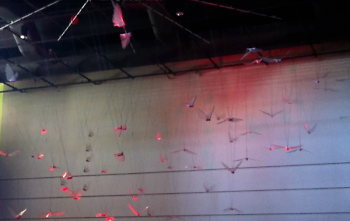"Is there work up there?"
"I'm not sure."
"I think I hear voices."
"Well, okay, let's go check it out."
My companion and I almost didn't go upstairs at UICA late Monday afternoon as we raced around to see work before Short List announcements. I had heard mixed reviews about the exhibit this year. One friend even sent me a text with just the venue name and a frowny face. Others, of course, had raved about their experience, and I was about to find out why.
Walking into a darkened square room with impossibly high ceilings, we saw Song of Lift by Martijn van Wagtendonk with over 100 "birds" high above us. Well, they're actually winged mechanical creatures. The mechanical structure is not hidden or apologized for in the entire piece; in fact it seemed to be a conscious visual choice to leave all of the workings exposed. The obvious mechanical structure of the piece makes it even more shocking to experience such a powerful response when the piece is put in motion.
Which happens when you put a quarter in the slot in the machine to the left.
As Henryk Gorecky’s Symphony No.3 Op. 36 starts to play, a few of the winged creatures start to move. Lights play with the movement, from above and below, casting shadows and changing colors. Everyone around looks up.
And stops.
More and more winged creatures start moving. The music builds. And builds. The entire mechanism starts turning, like the most graceful carousel. Talking stops, people stop and even children are motionless. Some of the crowd have dropped jaws for nearly the full five minutes of the "performance," many break into delighted smiles, and I even had tears.
Half an hour later, I was still there. Watching the performances. Watching the people caught up in the moment.
When I finally pulled myself away, it was to find out how I could get in touch with the artist. I needed to find out how anyone gets to this place of incredibly transformative work.
"It starts with a little idea and you start working things out. But partly because of the making process and the time it takes, things in my head get added and edited and it's almost like how I think intuition works. You learn a lot of stuff and you sort of store that in yourself… and then you find yourself making decisions that you're not always completely clear why or where it came from-but it's all that knowledge that you gathered over time. That's how this piece has become what it is now-because of that process," says van Wagtendonk.
Van Wagtendonk had a piece in ArtPrize two years ago as well, at the old UICA building, that slowly stopped working after a couple days.
"Two years ago I thought I would simplify it and I actually ended up doing the opposite, and it became more complex. You add complexity, you add possibilities of things not working properly," he admits.
Along with the risks he's taking with the mechanics of the work, van Wagtendonk also doesn't want to have control over the viewer's experience. The quarter machine, he says, is intentionally used to create ownership in the viewer.
"It's your quarter, it becomes your show. And since this thing is almost literally flying above you, it becomes your experience," he says. "It's very very very much about what you bring to the plate as a viewer. Hopefully therefore it becomes your piece and not the artist' piece."
In fact, through years of working on perfecting his craft, van Wagtendonk says the work has become more than his own ideas for it.
"Seeing, learning, making mistakes, trying new things, finding things out and then basically really working on the piece that's in ArtPrize right now... If you keep doing this, the work I think gets richer visually, and I also think it starts to live more of its own life," he says. "It needs people to actually come alive. To me it felt like no better place than ArtPrize to do something like that."
"What I had hoped would happen-the interaction that would happen-far succeeded my expectations. I already got my prize," says van Wagtendonk. "It's been so incredibly wonderful to see the people interact with it, and that really is the reward that made it all worthwhile.
Author note: I recognize the limitations of the above short video, and its inability to capture the experience visually or tangibly. Like many works of art, "Song of Flight" must be seen in person.
The Rapidian, a program of the 501(c)3 nonprofit Community Media Center, relies on the community’s support to help cover the cost of training reporters and publishing content.
We need your help.
If each of our readers and content creators who values this community platform help support its creation and maintenance, The Rapidian can continue to educate and facilitate a conversation around issues for years to come.
Please support The Rapidian and make a contribution today.
